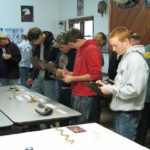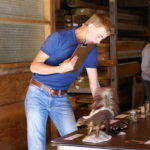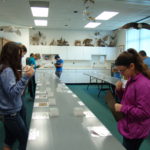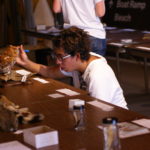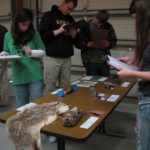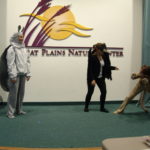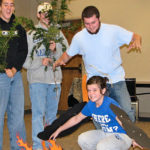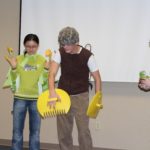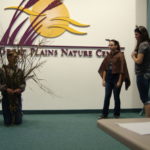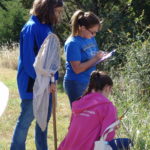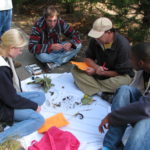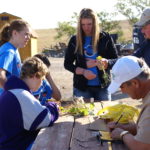So you want to make an Eco-Meet Team?
For more detailed tips and advice, check out this Eco-Meet Primer edition of On T.R.A.C.K.S. with articles from judges, coordinators, and coaches on every element of the competition:
Starting a Team
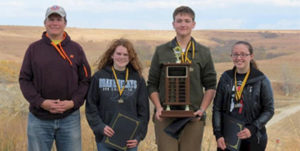
As a potential coach, you need to see if you have students that have an interest in the Kansas outdoors. They don’t have to be experts already, but they can’t be scared or hesitant to go outside and learn about what Kansas has to offer. The students that excel in Eco-Meet are not necessarily the smartest kids in school, but they must have a willingness to learn. We certainly understand that teachers are busy and don’t always have a lot of time to devote in the classroom to teach wildlife & plant identification, life history of the species occurring in the state, etc., but with the proper resources and some aptitude in outdoor activities, students can do really well in the competition.
A coach/teacher does not need to be an expert either. Check with your school librarian to see if any of the reference books we list are available. Science teachers might already have some of these books in their own rooms or in personal collections. Utilize the recommended online resources too, like the Kansas Herp Atlas and Kansas Wildflowers and Grasses. Being able to lead the students on field trips can be helpful, especially dealing with plant identification. There are also local resources (biologists, NRCS folks, state extension agents, etc.) that can be called upon to help you and your kids prepare for competitions. Good Eco-Meet coaches don’t have to spend a tremendous amount of time teaching if the kids show an interest and can work with each other to study the exam topics.
Obviously, if you are planning on starting a team(s) to participate in Eco-Meet, you need to secure the blessing of your school administration. Eco-Meet does align with science standards.
Once you have the administration of your school on your side, a great group of students selected to be on your team(s), and the reference materials you will need, you can start preparing for the competition.
Decide which Regional Eco-Meet you’ll be attending. Take a look at the Regional Map for this year to find the regional event closest to you. Your school may only attend one regional, but you’re free to select whichever regional event best works with your schedule. The top three teams from each regional event will go on to the statewide competition.
Each regional event handles registration differently, so be sure to review your regional event’s rules, and get in touch with your Regional Coordinator if you have any questions.
Focus Tests
Focus Tests are a huge component of Eco-Meet and represent half of the points that a team can earn. The topics rotate, so check the Rules and Regulations for this year’s study lists and recommended resources.
As a student preparing for participation in the competition, get familiar with the species that you’ll be tested on by reviewing and studying the lists provided. You don’t need to be experts, but even just knowing the species names on the list can help you be successful. While you can’t use reference materials during the exam, preparing study binders, notebooks, or index cards may be a useful strategy for studying.
Keep in mind that if your team has four students, the lowest team member’s score will be dropped from the team’s final score.
Interpretation
The Interpretive Event puts a team’s interpretive communication skills to the test. Students will assume the identity of native organisms to put on a 5-minute skit that conveys information to the audience about their plant or animal of choice.
The Characters
When selecting your cast, remember that you’re portraying both the species you selected and a character. Give your character a personality, and consider assembling a group of organisms that have a reason to interact. Does your cast share the same habitat? Are they migratory? Do they have similar reputations? Considering things like these may help you when brainstorming your plot.
Note, human beings, domestic animals, crop plants, and abiotic factors (rocks, oxygen, etc) cannot be portrayed by a student as their “species.” Each team member must select a different animal to portray (e.g., there cannot be four fox squirrels in a presentation).
The Story
To make your skit successful, you’ll need a solid plot or story. Having some conflict or a problem to solve keeps the characters interacting, and it gives them a reason to talk so they’re not just standing around spewing stats for no reason.
When brainstorming ideas, consider current or historic events in wildlife topics, politics, or pop culture, and look for inspiration in the relationships your plants or animals may have in the wild.
The Information
One of the easiest ways to score points in this event is to make sure all of the required information is presented in the skit.
- Make sure your information is accurate! This goes without saying, but you will not be awarded full points if judges question the accuracy of your information.
- Include lots of information! Although saying “Ornate Box Turtles eat fruit” is true, it doesn’t describe the animal’s diet accurately, which may cost your team points. In the same way, just describing the number of seeds a Common Sunflower produces is not an adequate description of the species’ life cycle and reproduction. When in doubt, give us more info!
- Present the information in interesting ways. While this doesn’t help your content score, it can help your score in Format and General Interpretive Techniques.
Costumes and Props
Using costumes, even extremely basic ones, does a couple things for your skit. It helps students get in character, and more importantly, it helps the audience and judges recognize which animals they’re portraying. Costumes don’t have to be elaborate, but having nothing at all can be a disadvantage to your team in most scoring categories.
The Skit
Now all that’s left is putting everything together! Review the guidelines to see what interpretive skills the judges will be looking for, and rehearse to make sure the skit uses the full five minutes.
Scavenger Hunt
The Scavenger Hunt tests a team’s identification skills in the field. Students will be presented with a list of 25 to 40 items including forbs, grasses, woody plants, animals, or miscellaneous items, and they have 30 minutes to identify and collect these items.
While taking a field trip to the site of your event may be helpful, the plants and other items on the list should be things that are fairly common in the wider area.
Here are some tips for tackling the Scavenger Hunt:
- Divide and conquer. The lists can be daunting, but if your team divides the studying so that each student has an expertise, tackling the scavenger hunt may be easier. Your team can also physically split up during the scavenger hunt, but some teams find it easier to stay together. Talk through your strategy before the competition.
- Study your basic biology. Not every item will be a species; you may be asked to find a specific type of fruit, leaf margin, a member of a specific family, etc. Know the basics!
- Know your field guide. You can use field guides during the scavenger hunt, but if you’re not familiar with your guide, it might slow you down.
- Remember the season. Many plants during the event won’t have flowers anymore but will still be identifiable by other features like seedheads. Keep the season in mind while studying!
- Bring scissors, resealable plastic bags, small containers, and other collecting equipment. These will help you stay organized and keep track of the items you collect. Some regionals provide these things, so you might check with your coordinator first to see what materials they recommend you bring. Keep in mind that your backpacks and other equipment you bring will be inspected by judges, so make sure there is no plant material left in these items.
Read the guidelines carefully! Observe proper collecting etiquette during the scavenger hunt, and keep in mind that each item may only be used once.
You might also explore iNaturalist and other sites or apps as a study tool for learning about the flora and fauna in your region. Just keep in mind that no phones, tablets, or other devices may be used during the event.
Still have questions? Contact your regional coordinator.


